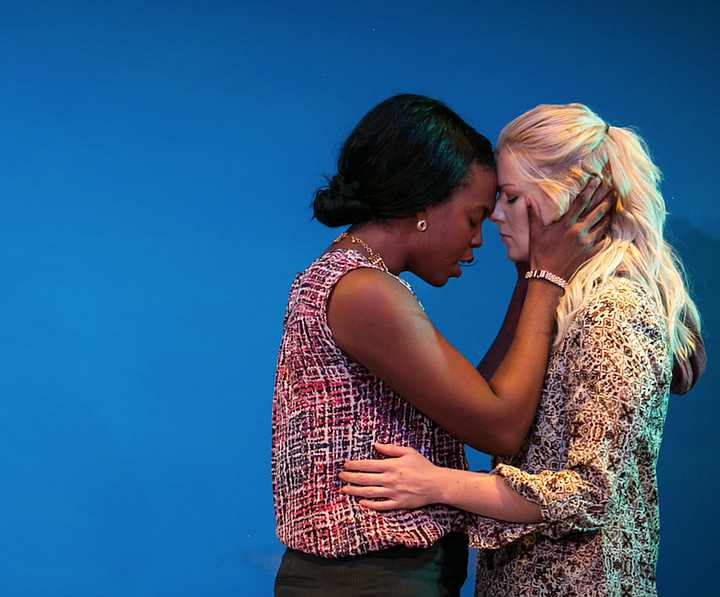 Facebook
Facebook
 X
X
 Instagram
Instagram
 TikTok
TikTok
 Youtube
Youtube

Tanya Barfield’s Bright Half Life revolves around the lives of Erica and Vicky, two women who meet at work and eventually begin dating. Over the course of the play they fall in love, get married, have kids, and eventually divorce. But instead of a linear timeline the play jumps back and forth over decades, showing snippets of their moments together. Some of these episodic scenes last several minutes, others mere seconds.
Rin Ehlers Sheldon plays the effervescent Erica and Bri Giger an authoritative Vicky. Both actors are on stage the show’s entire hour and twenty minutes. They shift and change to different moments and moods in the blink of an eye. Herculean stamina is required here, with so many transitions.
These ladies should be commended for their efforts, although they seem to struggle at times to capture all the elements they attempt to embody, such as the physical and vocal age of their characters. They also lack an authentic, onstage chemistry as a lesbian couple. Their kisses seem forced, touches prescribed, and conversations come across as at each other rather than to each other. Despite this, the audience cannot help but root for these actors and their characters as we witness both journeys simultaneously.

Transitioning from scene to scene, however, is an nagging issue with this production. Most are accompanied by a change in the lights and the actor’s positions, as well as a rushing sound akin to the audience being sped through time. These effects quickly become monotonous. Director Lydia Fort and her team miss dozens of opportunities to do other interesting things, such as different sound effects or stylized movements. In the hands of an inspired choreographer, more could have been told about the characters and the overall concept by saying more on stage with the bodies in transitions.
The use of a stationary set and one costume per character contributes to laborious transitions. For a play about continuously changing locations and times, changing only select visual elements seems counterproductive and redundant. Moveable set pieces and additional costume elements would have provided more visual opportunities to help the audience follow the story.
Bright Half Life is a refreshing change for San Diego theater. Seeing a lesbian couple on stage as the show’s only two characters, and presenting their relationship as nuanced and complicated while also simply romantic, is tremendously refreshing. Bright Half Life is a welcome play with a thought-provoking concept and story. The production, however, misses conceptual possibilities of a play about memory and how to communicate it best to the audience. It shines only half as bright as it could have.


Tanya Barfield’s Bright Half Life revolves around the lives of Erica and Vicky, two women who meet at work and eventually begin dating. Over the course of the play they fall in love, get married, have kids, and eventually divorce. But instead of a linear timeline the play jumps back and forth over decades, showing snippets of their moments together. Some of these episodic scenes last several minutes, others mere seconds.
Rin Ehlers Sheldon plays the effervescent Erica and Bri Giger an authoritative Vicky. Both actors are on stage the show’s entire hour and twenty minutes. They shift and change to different moments and moods in the blink of an eye. Herculean stamina is required here, with so many transitions.
These ladies should be commended for their efforts, although they seem to struggle at times to capture all the elements they attempt to embody, such as the physical and vocal age of their characters. They also lack an authentic, onstage chemistry as a lesbian couple. Their kisses seem forced, touches prescribed, and conversations come across as at each other rather than to each other. Despite this, the audience cannot help but root for these actors and their characters as we witness both journeys simultaneously.

Transitioning from scene to scene, however, is an nagging issue with this production. Most are accompanied by a change in the lights and the actor’s positions, as well as a rushing sound akin to the audience being sped through time. These effects quickly become monotonous. Director Lydia Fort and her team miss dozens of opportunities to do other interesting things, such as different sound effects or stylized movements. In the hands of an inspired choreographer, more could have been told about the characters and the overall concept by saying more on stage with the bodies in transitions.
The use of a stationary set and one costume per character contributes to laborious transitions. For a play about continuously changing locations and times, changing only select visual elements seems counterproductive and redundant. Moveable set pieces and additional costume elements would have provided more visual opportunities to help the audience follow the story.
Bright Half Life is a refreshing change for San Diego theater. Seeing a lesbian couple on stage as the show’s only two characters, and presenting their relationship as nuanced and complicated while also simply romantic, is tremendously refreshing. Bright Half Life is a welcome play with a thought-provoking concept and story. The production, however, misses conceptual possibilities of a play about memory and how to communicate it best to the audience. It shines only half as bright as it could have.
Comments